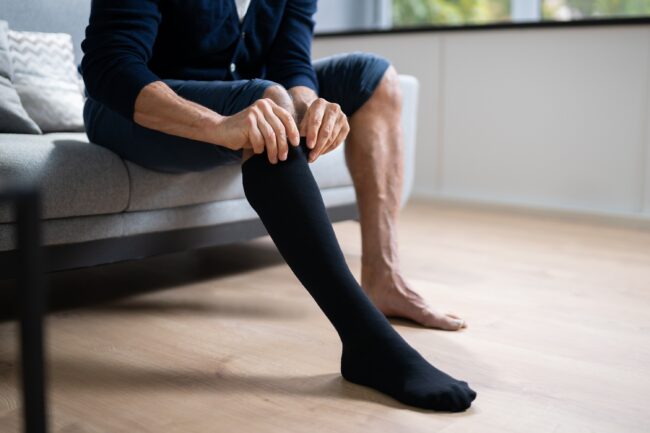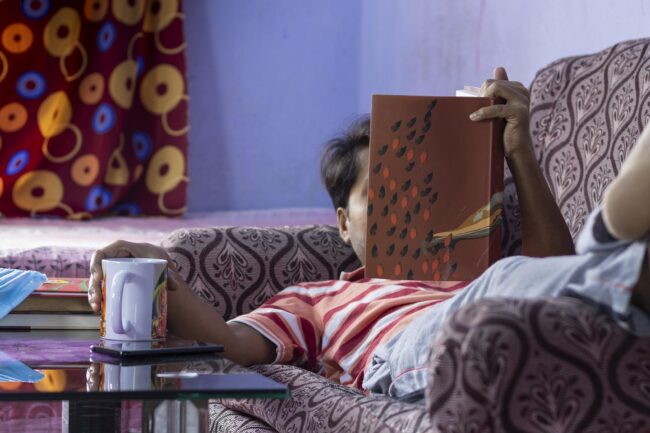9-Step Post-Operation Guide
As with many operations, a varicose vein treatment has a few extra steps you’ll need to take after leaving the doctor’s office. So to ensure you’re taking the best care of yourself and your veins, here’s our 9-step post-op care guide.
1. Wear compression stockings

Man Putting On Medical Compression Stockings On Legs
Compression stockings are designed to help you maintain healthy blood flow through gentle pressure. Wearing them after your varicose vein treatment (whether it was Endovenous Laser Ablation, medical superglue, or Radiofrequency Ablation) is helpful as the stockings will reduce discomfort and bruising.
Graduated compression stockings get tighter as you go down toward the ankle. This often makes below-the-knee stockings the best choice following vein treatment. Indeed, they put the greatest degree of pressure on the lower area of your legs, where it is needed. Your doctor will determine which compression level you need and how long to wear them.
The Vein Institute provides compression stockings as part of your after-care package, at no additional charge. Also, there are two lengths of stockings which we recommend:
- a) Knee-high stockings
- b) Thigh-high stockings
Compression levels are measured in mmHg and they include:
- 8-15 mmHg (Mild Compression)
- 15-20 mmHg (Moderate Compression)
- 20-30 mmHg (Firm Compression)
- 30-40 mmHg (Extra Firm Compression)
Guidelines vary among countries and regions for the compression level and length of use. Most often, we prescribe firm compression for post-surgical and post-sclerotherapy treatment. Although there is some debate about their benefit, patients often report less swelling and a mild reduction in pain with their use following treatment.
You may need to wear the stockings for anywhere between 3 days and 2 weeks, depending on your doctor’s recommendation and the type of treatment you received. VenaSeal treatments, for example, generally require less compression time than ablations.
During the compression period, we recommend only taking them off if they become too uncomfortable or if you feel them cutting off your blood supply. In these cases, the stockings likely got wrinkled or pulled too tight, so be sure to adjust them.
You can also take the stockings off before going to bed. Just make sure to put the stockings back on in the morning before your feet touch the ground.
2. Walk to boost circulation
Similarly, walking helps maintain healthy blood flow and prevent blood clots, which is why you should take the time to go for a 30-minute walk daily for 2 weeks, including right after your procedure.
When you walk, you might be inclined to keep the weight off your treated leg due to discomfort. However, we advise that you continue walking as normally as possible. Varicose vein treatments don’t affect muscles, bones, or joints, so the pressure won’t damage them. You want to make sure that the limb receives all the benefits of improved circulation during your walks.
3. Avoid strenuous exercise
Gentle exercise like walking is good after a varicose vein procedure. But, more strenuous exercise like weightlifting, running, and team sports causes heavier blood flow, risking straining the veins and causing unpleasant symptoms. So, you should also avoid strenuous activities for at least 3-5 days after your treatment.
4. Elevate your legs

It’s also beneficial to elevate the site for around ten minutes daily for a week after your procedure. This will help your blood flow back to the heart and reduce the pressure on the healing veins.
5. Avoid sitting or standing for long periods
Remaining static for too long, especially when sitting or standing, can reduce your circulation and force your veins to do some heavy lifting to maintain a healthy blood flow as they strain against the gravitational pull. So, keep it to a minimum for at least the first week after the varicose vein treatment. Or, at the very least, take breaks to wander around, lay down, or elevate the site at regular intervals.
6. Avoid waxing/shaving
Generally, this rule only applies to the treatment site. You can still wax or shave around your compression sock. Or even under it, provided you’re not putting pressure on the limb while the stocking is off and provided there is no scabbing around the site.
Once you can stop wearing your compression socks and there’s no damaged skin left around the site, you are free to resume your regular grooming routine.
7. Keep an eye out
Some staining and oozing around the treatment site is normal, as is some post-treatment pain, bruising, swelling, redness, and in the case of endovenous laser ablation, some patches of numbness. Your compression socks will help alleviate some of the discomfort, and we would recommend taking Paracetamol as needed to help manage it further.
In the unlikely event of uncontrolled bleeding, fever, pus, or pain that won’t go away even with pain medications, contact your doctor as soon as possible.
8. Keep the site clean and dry
Your doctor will apply gauze to the treatment site, which needs to stay on for 24-48 hours. Once you take the gauze off, apply antibiotic ointment to the site and use bandaids as needed until the site heals.
You also need to avoid lakes, pools, and hot tubs for 1 week as you may never know what may be swimming around there. You should also avoid baths for at least 3 days and take care to wear a shower cover if you need to shower within 24 hours after treatment.
9. Eat your normal diet
Lastly, we think you’ll be happy to know that there are generally no strict dietary restrictions after varicose vein treatment. You are free to eat sweets, bread, and meats.
But, keep in mind, there are certain food items that aren’t great for your veins. Foods that increase water retention (salt) and reduce circulation (grease and alcohol), might increase the likelihood of you developing varicose veins again. So if your doctor advises you to eat or drink less of such food items, do so.
In short
Take good care of your veins after treatment for a more comfortable recovery, the most important thing to remember here is to avoid activities that can strain the veins and to do activities that take the pressure off them.
You should also note that while the above guidelines are good rules of thumb, varicose veins are never identical from patient to patient, and everyone responds differently to treatments. Hence, your doctor may recommend additional care steps or extended/reduced time frames, depending on your condition.
If you have any other questions about post-op care, feel free to contact us at 13 VEINS (that’s 13 83467).
And if you want to learn more about varicose vein causes, prevention, and treatments, explore the resources on our site and be sure to follow us on Facebook or Instagram




